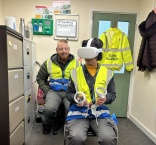Home › magazine › special features › Virtual reality the future of training
Virtual reality - the future of training
28th of June 2024Debbie Jamieson, HR projects manager at building services provider Churchill Group, explores why training is so important in our sector, the benefits of using VR and how every business can create and implement a VR training programme for their workforce.
TRAINING AND DEVELOPMENT programmes are one of the most powerful things we can offer employees. Stats compiled by HR Exchange Network state 68 per cent of employees say training and development is a company’s most important policy, while 76 per cent are looking for career growth opportunities.
There’s a strong business case as well. The Huffington Post reports companies offering comprehensive training programmes have 218 per cent higher income per employee than those with less comprehensive training and enjoy a 24 per cent higher profit margin than those who spend less on training.
We’re all passionate about supporting cleaning operatives by creating valuable career paths and making the industry attractive to the next generation of the workforce. Yet many training methods still often involve spending hours in a room or online reading manuals and guides.
It’s time to revamp how we deliver training, and virtual reality (VR) is one of the ways forward.
There are numerous stats that highlight the benefits of VR training. VR-focused training company Virtual Speech says:
• VR training drives a 76 per cent increase in learning effectiveness compared to traditional methods
• Employees can be trained four times faster in VR courses than in classrooms
• Learners who undergo VR training demonstrate up to a 275 per cent increase in confidence to apply what they’ve learned, far higher than classroom (40 per cent) and e-learning (35 per cent)
• VR learners report feeling 3.75 times more emotionally connected to the training content than those in traditional classrooms and 2.3 times more connected than e-learners
• VR-trained employees are up to four times more focused during training compared e-learners and 1.5 times more focused than classroom learners.
The same study notes the positive impact that VR training has had in a variety of fields, from healthcare to mining. There’s no reason that it can’t be adapted for the cleaning sector – and that’s exactly what we did at Churchill Group.
Our VR programme was designed for cleaning operatives who work on our rail contracts. Specifically, the turnaround cleans when a train has reached its final destination. The beauty of VR is that you can create a scenario for any situation, so there’s no reason why it can’t be used for an office setting, hospital or a school. You can even recreate the exact setting in VR so that operatives can practice as if they were there.
VR is also a much more inclusive option as it touches on all of the visual, aural, reading/writing and kinesthetic (VARK) styles of learning to some extent. It can be delivered in different languages so that all employees can take part, and the engaging experience is much more impactful for people with neurodiverse conditions, such as ADHD, than traditional methods.
Starting the VR journey
The first step is to form a small in-house project team comprised of key stakeholders - such as HR, operations and account leads from the relevant business divisions. Define your goal early on and be clear about what you want to achieve. We didn’t have the in-house expertise to design the VR system, so we identified a partner and worked closely with them throughout the process.
Create a project plan that includes timeliness and meeting schedules. We found it best to meet weekly, but others may want to meet more or less frequently depending on availability and the progress of the platform. The meetings must be in-person as you’ll want to test the software each time. Make sure to precisely define the programme’s scope to cover essential topics relevant to your operations.
You can also think about other elements you could incorporate into the training. For example, we integrated security protocols, such as suspicious packages, to enhance the security awareness of
our cleaning operatives to meet rail industry requirements.
Delivering the training
VR headsets such as the Oculus Quest 2 come with handheld controllers, are affordable and easy to transport between sites. You can deliver training to as many people at one time as you have headsets, across various locations. This flexibility is crucial in addressing the disparate nature of the workforce and mitigating the hidden costs associated with training, such as inconsistent messaging and time-consuming training methods.
The headset, a laptop and a chair are the key bits of physical kit you need to get started. You’ll also want to make sure you have a suitable room, and perhaps a big screen as well so that others in the room can watch as the user goes through the programme.
We noticed that users often find it hard to resist the temptation to move around if their chair has wheels, even though programmes can be completed sitting still. The controllers are used to ‘move’ around inside the VR platform, while the user just needs to move their head to look around.
It’s worthwhile having the user start inside some sort of training centre where they can receive an introduction to the programme and can get used to using the headset and controls. Though VR headsets are becoming more popular, lots of people still haven’t used them before so you’ll want to make sure they are comfortable before the actual training programme starts. We had users pick up and throw a basketball to get them used to how the controls work.
Then you can have them go through the training you have devised. In our platform, we have users take part in a timed turnaround clean of a train carriage as the final part of the programme. They have to collect rubbish, check toilets, spot graffiti, and make it off the train before time elapses. Users receive a score at the end and can see which things they may have missed.
You can record the training so that any designated person can watch it back. This allows a manager to live through a user’s journey and see where they performed well and where they struggled.
You can even utilise technology to track users’ eye movements, providing invaluable insights into their performance and learning patterns. You may notice that someone frequently struggles with the left side of their vision, for example, which will help you address the problem and support that person. This type of insight is simply not possible in a classroom and helps to truly tailor the learning experience to each individual.
Fantastic feedback
More than 200 cleaning operatives have completed our VR training course so far and the feedback from trainees has been overwhelmingly positive. One hundred per cent of participants said that they enjoyed the experience, and 95 per cent said they would recommend it.
Feedback from trainees includes:
• “I like the fact it was immersive and an interesting way to learn as opposed to our current way of learning.”
• “The environment was very realistic; the start of training was great, and we had a lot of time to complete and learn.”
• “If you apply for a cleaning job, I think individuals will be excited to go through this experience.”
When asked if they would recommend the programme, respondents said:
• “I definitely would - we can develop scenarios that cause the most common problems. It definitely makes you feel you are there and in the moment.”
• “Yes - this brings it to life in a different way as it’s not just visual, but it hits all of your senses instead of just reading something.”
• “I’m really, really impressed by it. The whole process from beginning to end encompasses what we do in the role.”
Trainees appreciate the immersive and interactive nature of the training, and also recognise our commitment to their development and value as team members.
One of our rail clients tried the programme and responded enthusiastically. They highlighted the programme’s innovative and engaging nature and were thrilled to see how we are supporting our colleagues to better support them.
Business case and future plans
While we developed this for the benefit of our colleagues and clients, it does of course need to be commercially viable. We expect our investment to be returned within a year through cost savings and enhanced business opportunities. The programme will cut costs by reducing training time, increasing employee retention and easing the burden on account managers responsible for training.
The beauty of this software lies in its adaptability and scalability. As technology continues to advance, you can continue to improve the programme and explore new possibilities. This may be creating different settings and making improvements based on user feedback.
For example, we’re planning to design a more universal experience that accommodates individuals with neurodiverse conditions and to introduce more language options to ensure the platform is as inclusive as possible.
Our VR training programme represents a pioneering innovation in the FM sector, and I’d encourage others to follow suit. It will showcase your commitment to your employees and clients, and there are simply too many reasons not to adopt VR for at least part of your training portfolio.












